Asset list⚓︎
note:Cloud Synchronization is feature of JumpServer enterprise edition
note:Oracle, PostgreSQL, SQL Server, and ClickHouse databases are all features of JumpServer Enterprise Edition.
1 Asset tree and asset categorization tree⚓︎
1.1 Asset tree⚓︎
- The asset tree categorizes asset types and allows for multiple dimensions of categorization for each asset. For example, assets can be categorized based on organization, project, protocol, etc.
- After categorization, user permissions can be flexibly assigned to efficiently manage hosts.
- Root nodes of the asset tree cannot be duplicated. Right-clicking on nodes allows for adding, deleting, and renaming nodes, as well as performing actions related to assets.
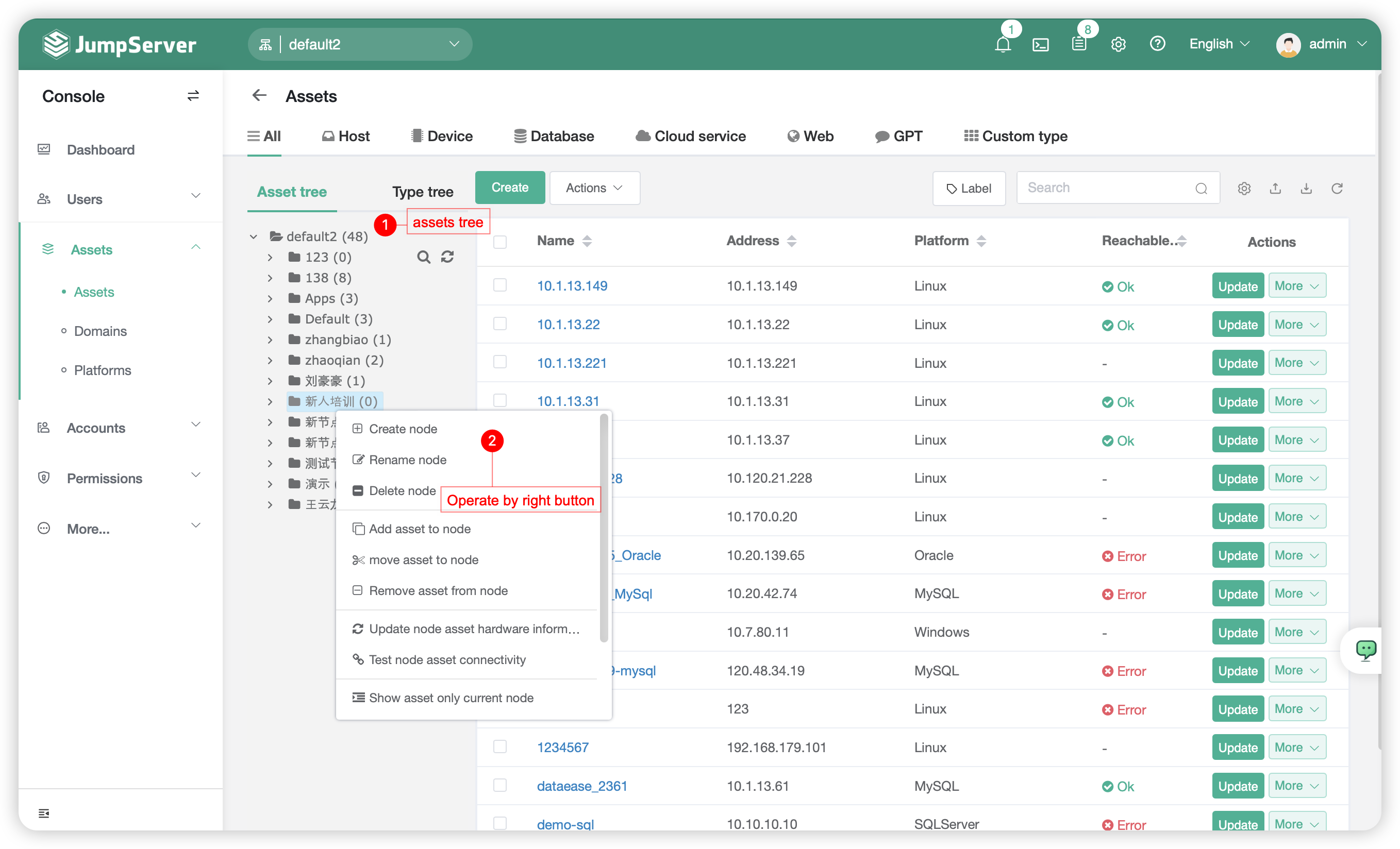
- Detailed parameter description:
| Parameter | Description |
|---|---|
| Create node | Create a new sub-node under current node |
| Rename node | Rename current node |
| Delete node | Delete current node |
| Add asset to node | Adding assets from other nodes to the current node will not remove assets from the original node |
| Move asset to node | Moving assets from other nodes to the current node will remove assets from the original node |
| Update asset hardware infomation from the node | Initiate an automated task to batch update hardware information for assets from the current node note:The functionality requires that assets from the current node have automated tasks enabled and are configured with the correct privileged user, supporting only the SSH protocol |
| Connectivity test of asset | Initiate an automated task to batch update the connectivity of assets from the current node note:The functionality requires that assets from the current node have automated tasks enabled and are configured with the correct privileged user, supporting only the SSH protocol |
| Display assets from current node only | Display asset from current node only, do not display assets of the sub-nodes |
| Display all assets from sub-node | Display assets from both the current node and all sub-nodes, regardless of whether the sub-nodes have multiple layers of sub-nodes |
| Verify the number of assets | Verify the number of assets from current node |
| Detailed information of node | Display detailed node information,include node ID, name and full name |
1.2 Asset type tree⚓︎
- The Type Tree is another way to categorize assets in JumpServer. Hosts, network devices, databases, and others are all classified as assets in JumpServer. The Type Tree is primarily used to provide a more intuitive view of asset distribution by counting the number of each asset type.
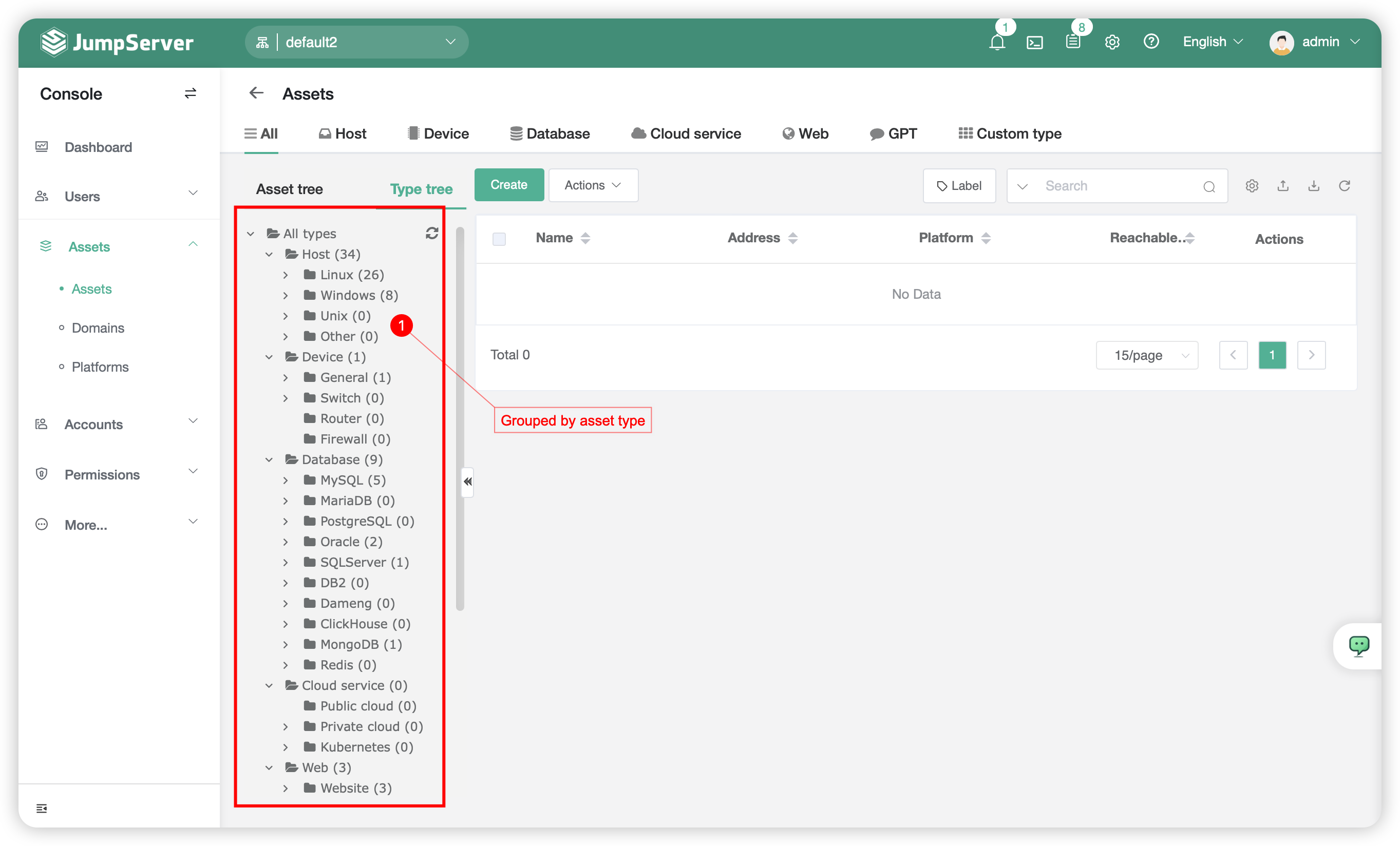
2 Asset type⚓︎
- JumpServer classifies hosts, network devices, databases, and other entities as assets within the JumpServer platform.
- Administrative user have the ability to customize platform types within the platform list.
- Host type by default include Linux、 Windows、 Unix host and others.

- Network device type by default include General、Cisco and others.
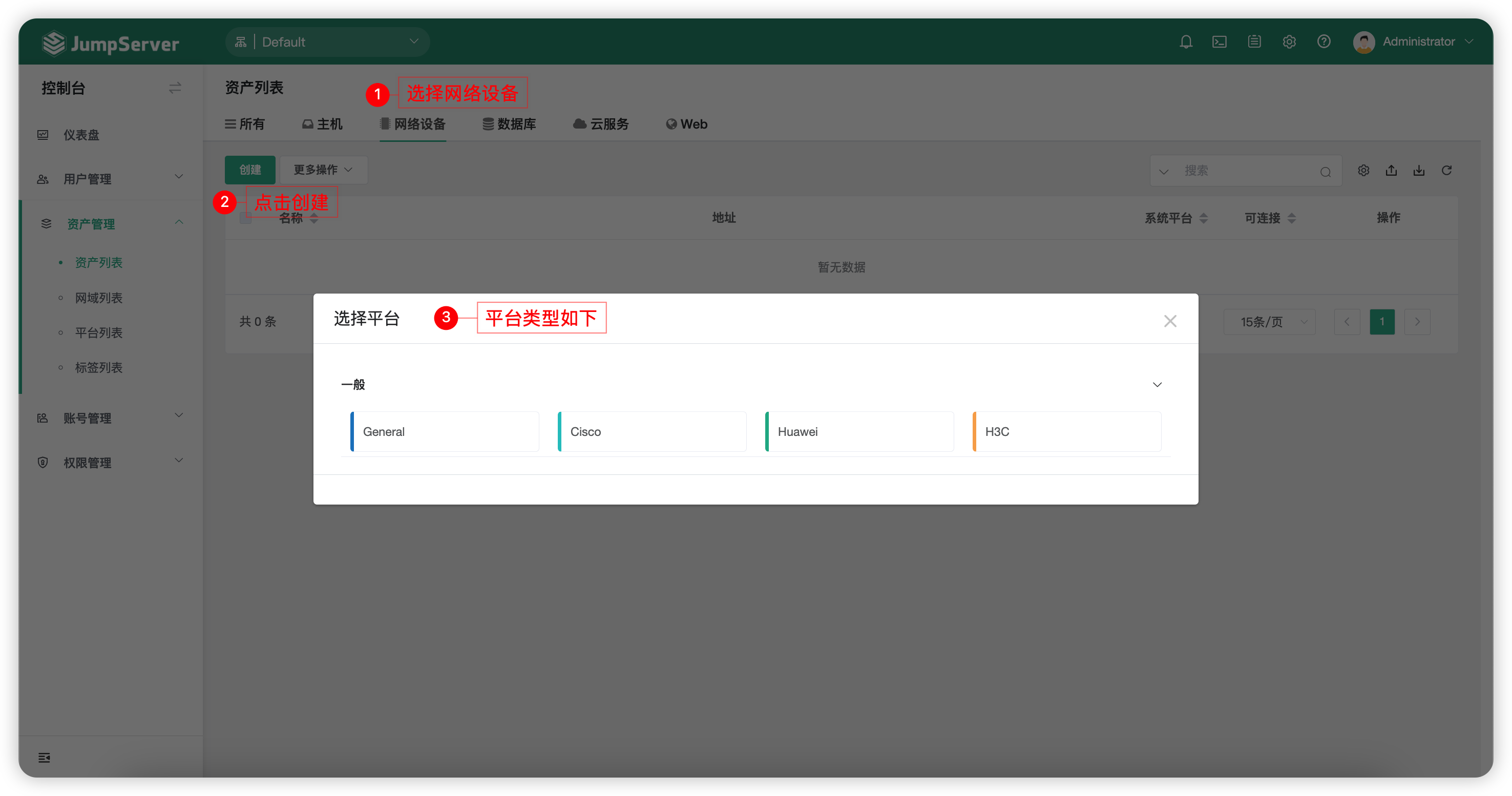
- Database type by default include MySQL、MariaDB、Oracle、Redis and others.

- Cloud service type by default include Kubernetes.

- Web type by default include Web site.
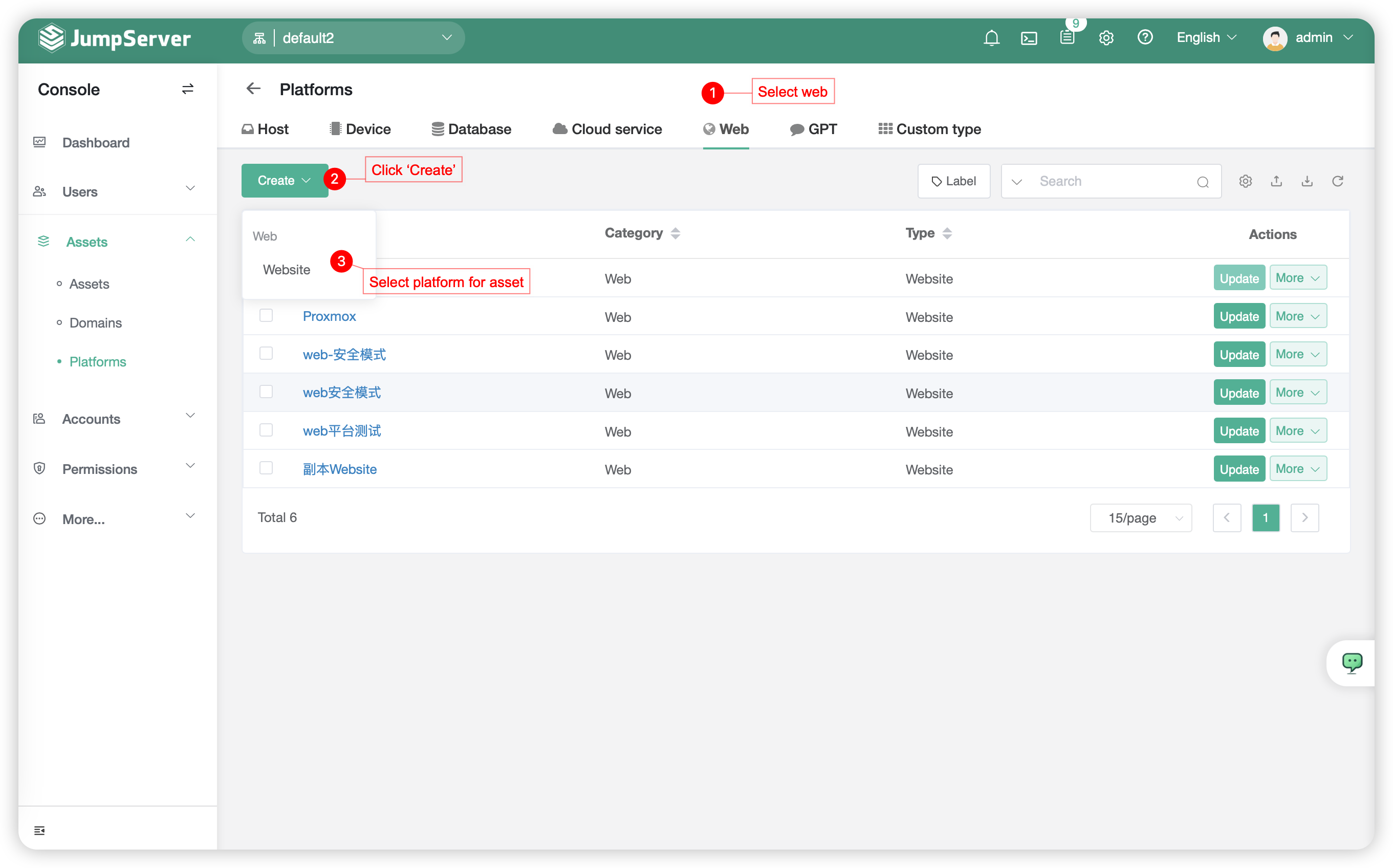
3 Create asset⚓︎
3.1 Create asset manually⚓︎
- JumpServer supports manual asset creation, which involves inputing essential information such as asset details, accounts, node information, and other necessary data.
- Click on the asset category to access the selected category page (eg. Host page).
- Website creation reference
- Click on the
Createbutton at the top left corner of the page to access the asset creation page. Fill in the detailed asset information on this page.。
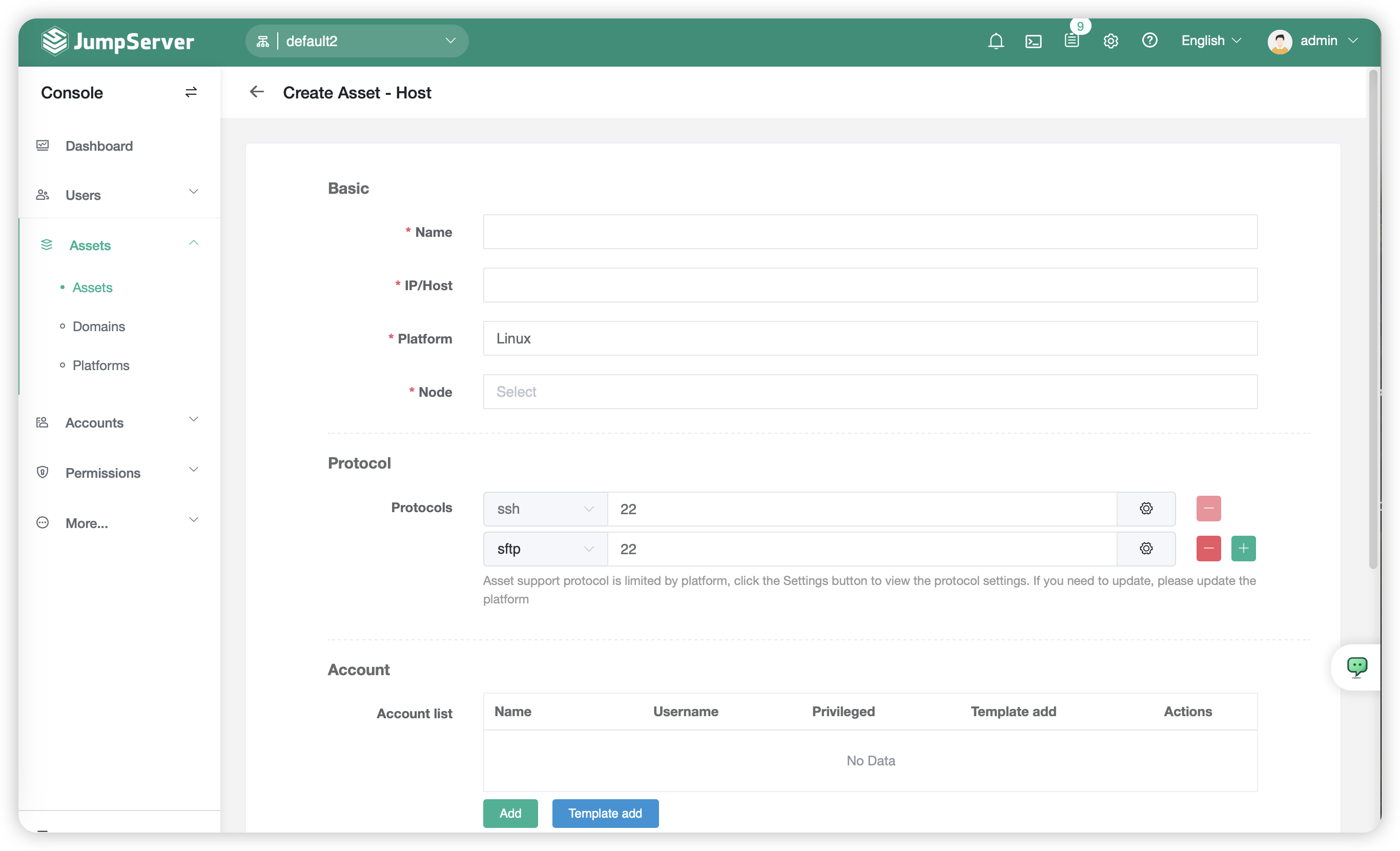
- Detailed Parameter Description:
| Parameter | Description |
|---|---|
| Name | Mandatory, The name of the asset in JumpServer, which is unrelated to the asset's actual computer name and cannot be duplicated |
| IP/Host | Mandatory, Real IP, VIP, or domain name of the asset. Duplicates are allowed |
| Asset platform | Default,The asset's platform includes different character encodings, connection parameters, and password change commands that can be set for each platform |
| Node | Mandatory,the node of asset |
| Protocol group | Mandatory,Protocols used for accessing assets, you can select one or more |
| Account list | Mandatory,account of the asset and you can create accouts binging with the asset |
| Network domain | Optional,Access to certain assets across different networks requires SSH proxy access through a domain gateway (sshpass) |
| Label | Optional,add label for asset to facilitate management |
| Activated | Mandatory,whether the asset is usable |
3.2 Batch import assets by Excel⚓︎
- JumpServer supports to create and update assets by batch importing assets with excel
- JumpServer support two import templates,csv template and xlsx template
- To import your assets, you can start by clicking on the
Importbutton present in the top-right corner of the asset list. Next, download the import template and follow the instructions mentioned in the template to fill in the required information for the import or update. Once you have filled in all the necessary details, you can import the file on the import page.
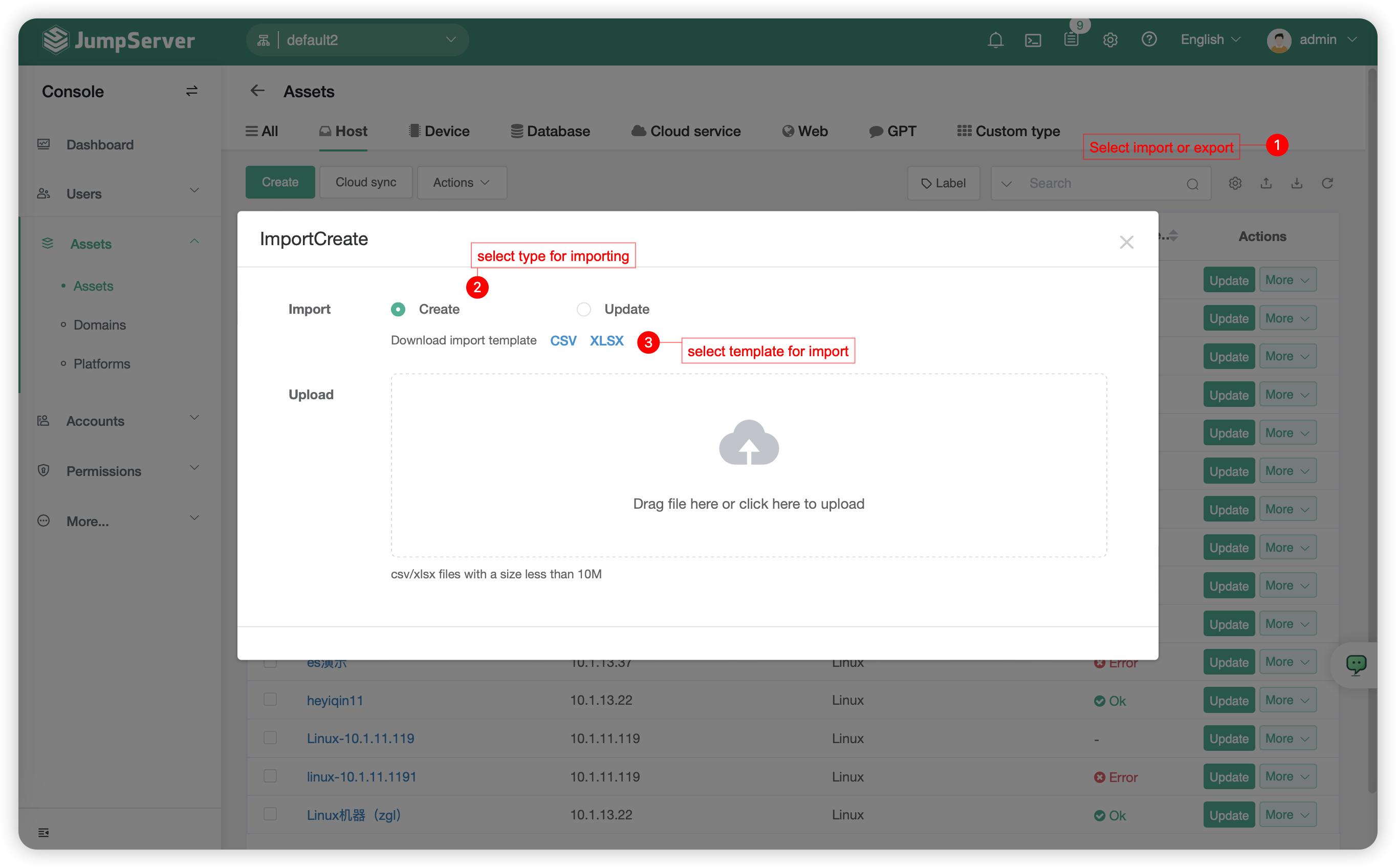
3.3 Cloud Synchronization⚓︎
- JumpServer support synchronization of cloud host.
- The cloud synchronization feature supports syncing cloud assets to the JumpServer.
- By creating cloud accounts and sync instances, you can sync assets from Alibaba Cloud, Tencent Cloud, Huawei Cloud, Baidu Cloud, JD Cloud, Kingsoft Cloud, AWS (China), AWS (International), Azure (China), Azure (International), Google Cloud, VMware, QingCloud Private Cloud, Huawei Private Cloud, China Telecom Private Cloud, OpenStack, Nutanix, Fusion Compute, LAN, and other cloud assets to the JumpServer asset list.
- Click on
Asset listin the left side of page and switch to the page of asset list - Click on
Hostpage tab in page of asset list,then click onCloud Syncbutton,switch to page of cloud syncronization

- Click on the
Account Listpage tab on the cloud sync page to create a cloud account. Taking Tencent Cloud as an example, obtain the relevant keys from Tencent Cloud's account page.
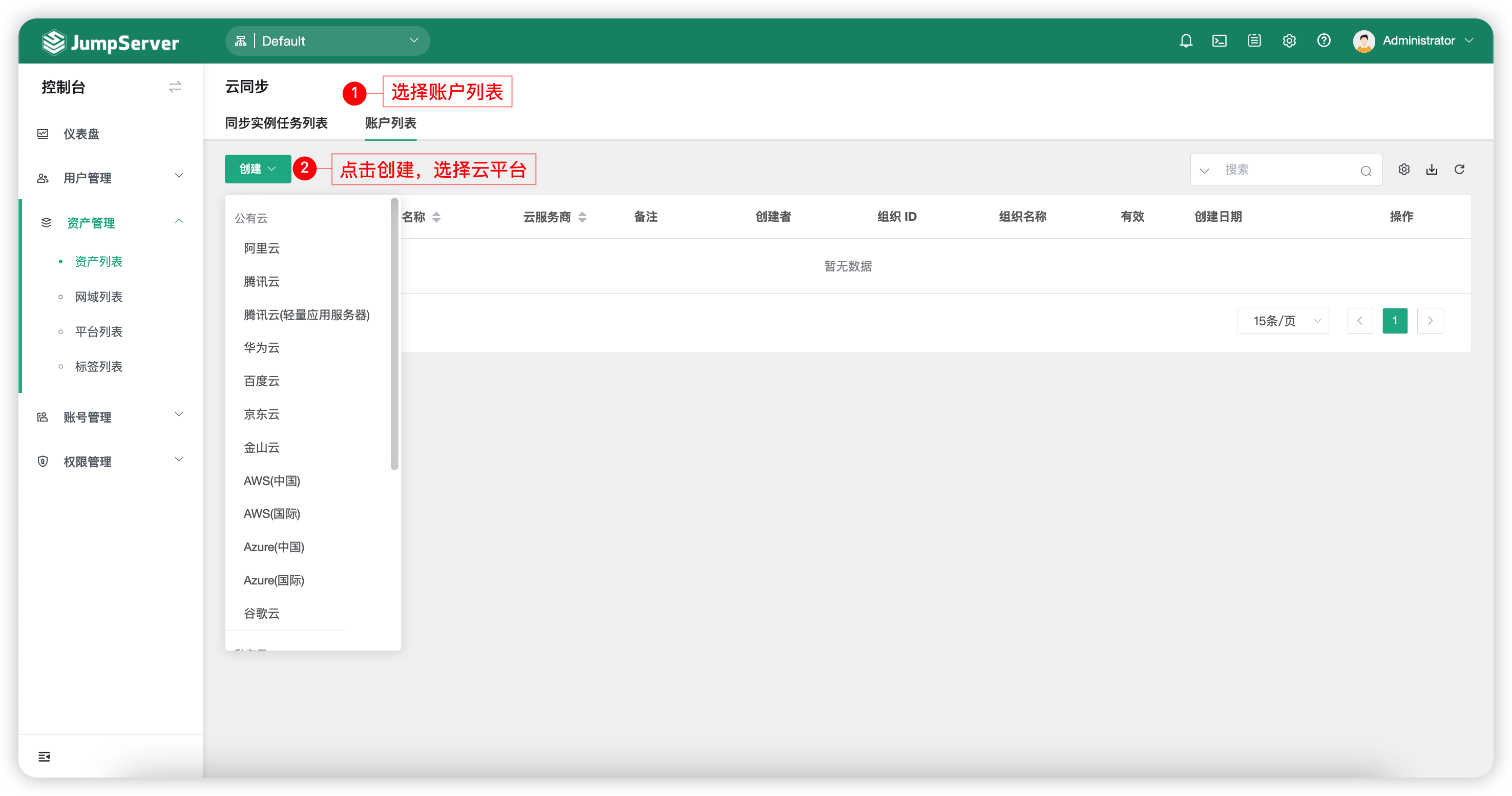
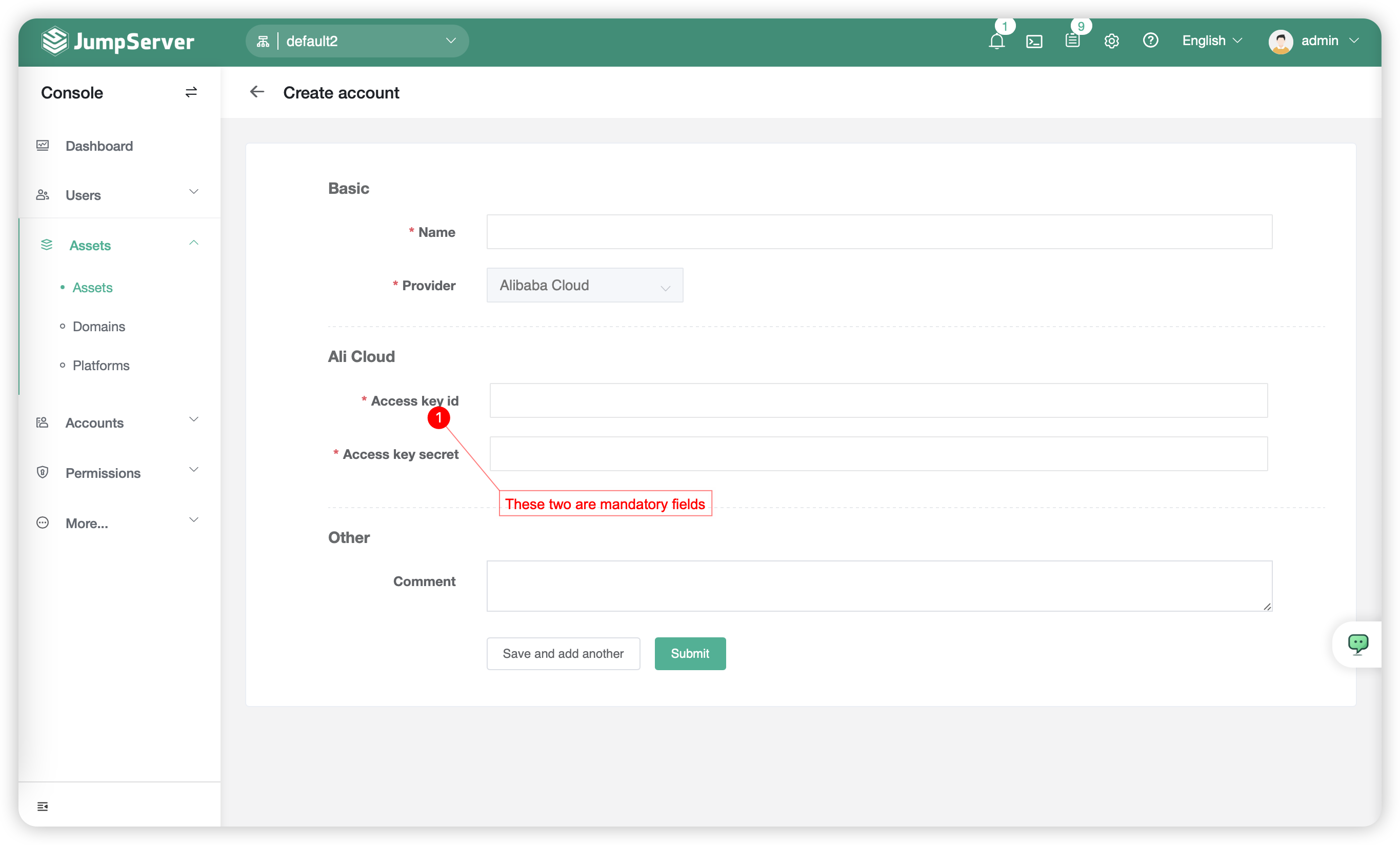
- Click on
Synchronization Instance Task Listpage tab in page of cloud synchronization,and then create task for cloud synchronization
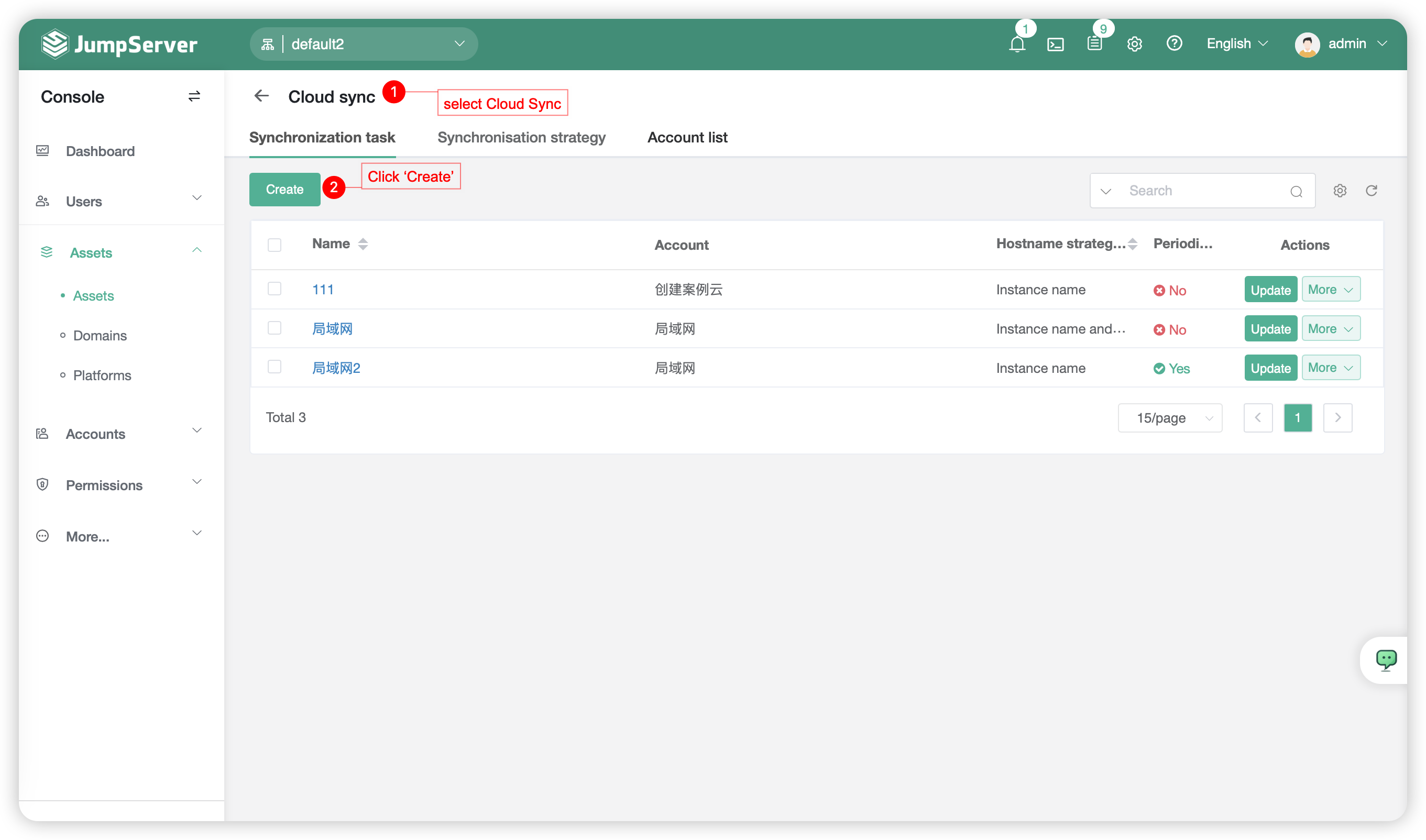
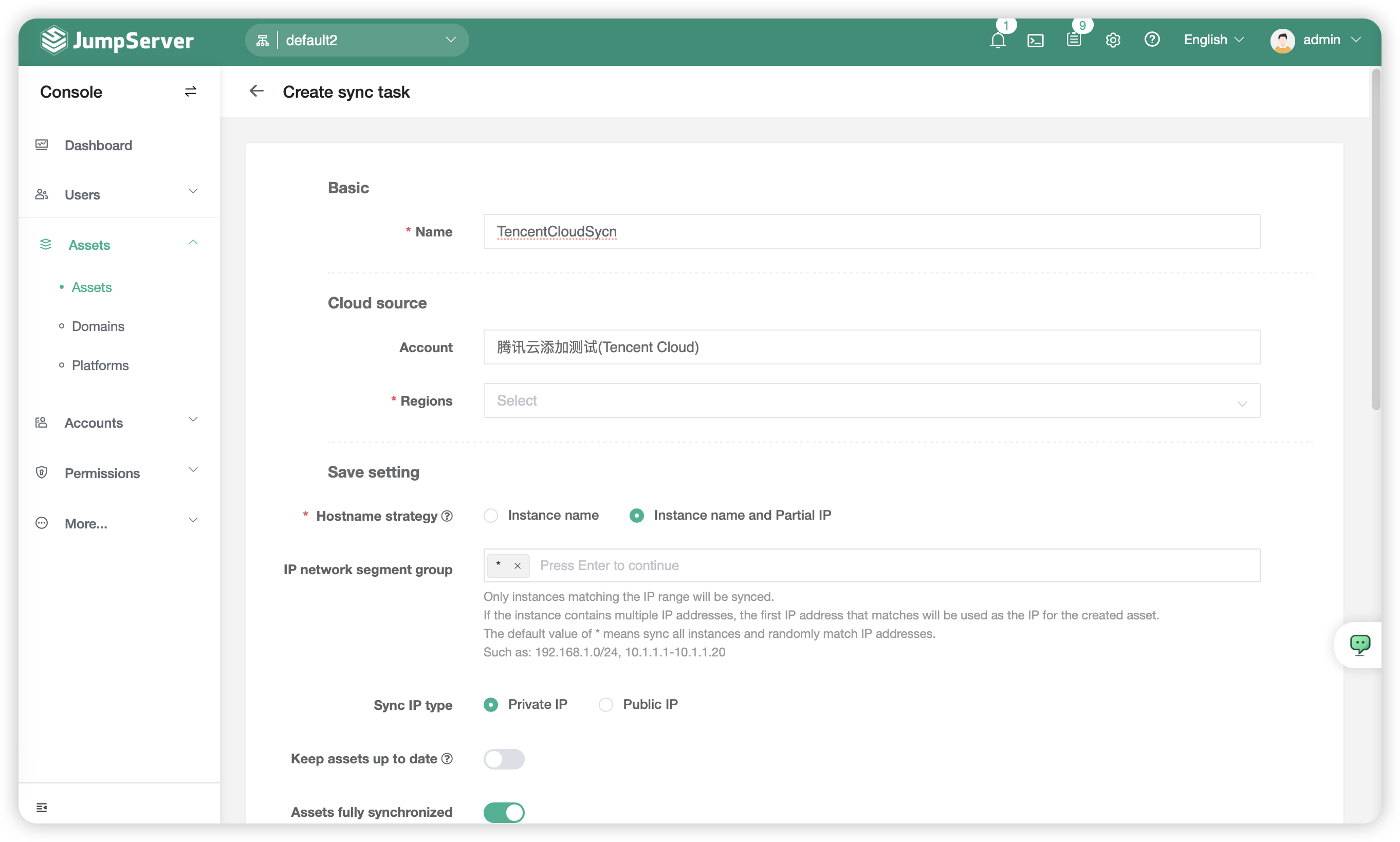
- Detailed Parameter Description:
| Parameter | Description |
|---|---|
| Name | Task name of synchronization |
| Account | The source account for synchronization refers to the accounts in the account list |
| Region | Recognizable regions in the account list refers to the region where assets requiring synchronization are located |
| Policy of host name | Choose either "Instance Name" or "Instance Name + Partial IP" to sync the asset's hostname |
| Node | Sync the node name of the asset |
| Protocol group | Sync the protocol group that asset support |
| Group of IP Segment | Sync the IP subnet group associated with the asset. If the match is successful, the asset can be synced |
| IP type of Synchronization | Sync the IP type of the synced asset, whether it's a private IP or a public IP |
| Keep asset information up to date | Does the synchronization task update all asset information each time it's executed? |
| Scheduled execution | Is scheduled execution enabled? |
- Click on the
Submitbutton, the synchronization task will be created. - Synchronization tasks can be scheduled or executed manually.
- Manual execution involves clicking on the
Morebutton next to the synchronization task, selecting theExecutebutton, and then executing the synchronization task.
4 Asset update⚓︎
- When there's a need to update information for a specific asset, click on the
Updatebutton next to the asset. This will take you to the asset information update page, where you can update the relevant asset information.
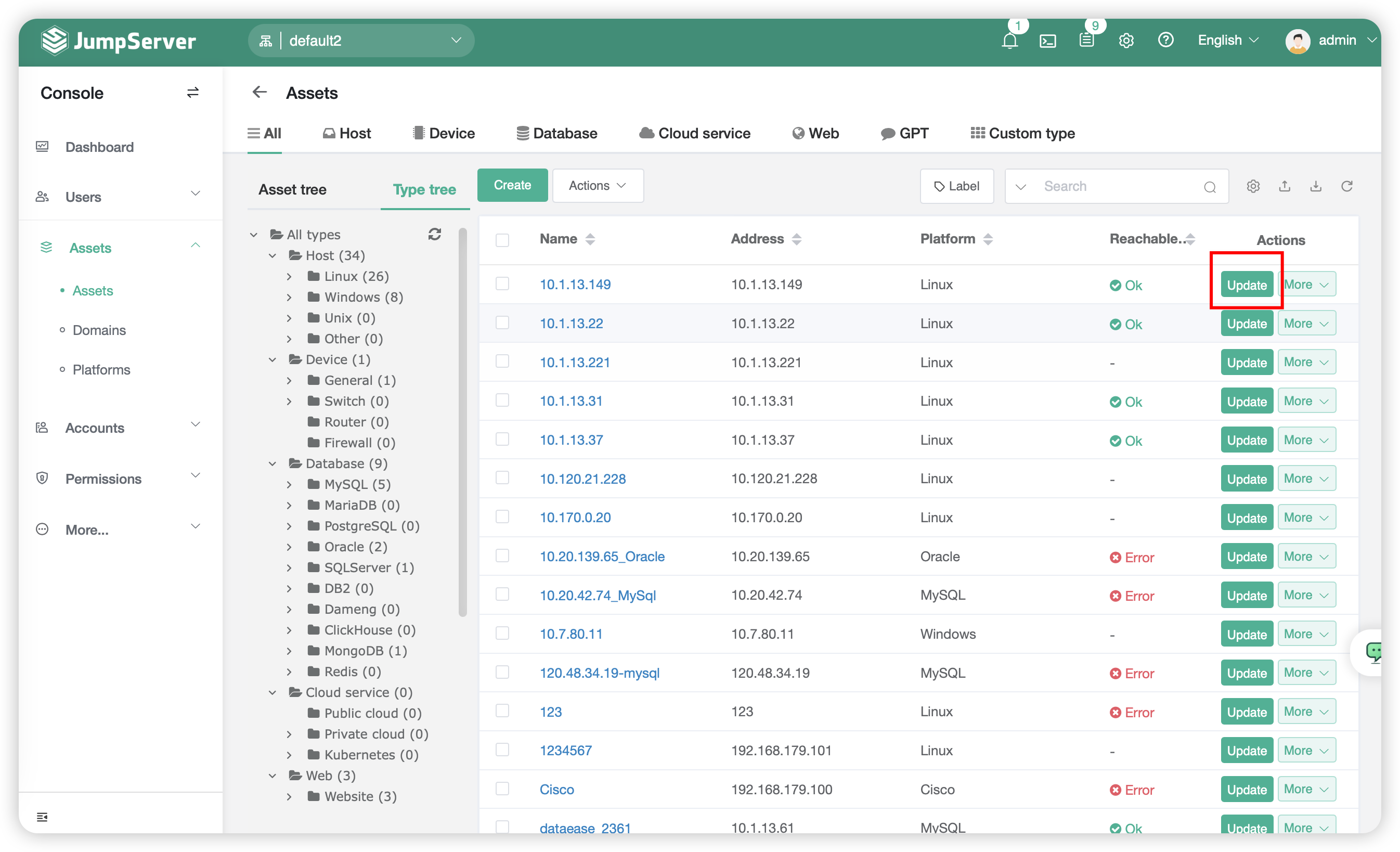
5 Asset details⚓︎
- Click on
Asset namein page ofAsset list,then intoAsset details。 - The page of Asset Details includes information such as basic asset details, asset account list, authorized users, and asset activity records.

- Parameter Detailed Description:
| Parameter | Description |
|---|---|
| Basic Informaction | The Basic Information module primarily introduces asset details, including name、 protocol、 asset platform and so on |
| Rapid Update | The Rapid Update module primarily performs automated tasks for assets, such as updating hardware information and asset connectivity |
| Node | The node module can modify the node of the asset |
| Label | The label module can view the lables of asset |
| Acclount list | The account list module primarily inculdes account infomation bounded to asset,users can add、 delete、 check and update account with it |
| Authorized user | The Authorized module primarily introduces the users and user groups authorized for the asset and allows for viewing corresponding authorization rules |
| Activity log | The Activity Logs module primarily displays the last 30 logs related to the asset, including update logs and session records |
6 Asset deletion⚓︎
- To delete a specific asset, click on the
Morebutton next to the respective asset, select theDeletebutton, and confirm the deletion to proceed.
